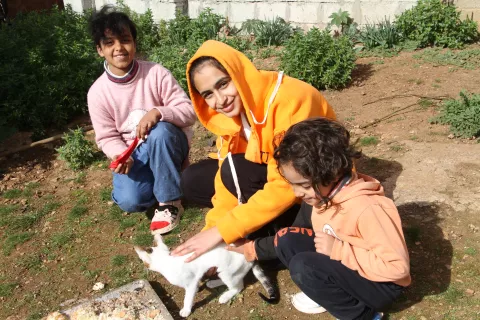Little Hiba’s Journey from Malnutrition to Recovery
UNICEF supports children and mothers in rural Damascus with nutrition and health services

Rural Damascus, Syria, 26 April 2021 - Six months ago, Mirvat brought her 7-months-old baby, Hiba, to a UNICEF-supported health centre in Sahnaya, Rural Damascus, where she was diagnosed with severe acute malnutrition.
“She was strikingly skinny, like a little skeleton,” says Mirvat, holding back her tears.
“She wasn’t my first child to be malnourished; I almost lost her sister before.”
Mirvat’s plight started a little over eight years ago, when violence escalated in East Ghouta, Rural Damascus, forcing her to flee with her husband and two children. This first displacement was followed by seven months of siege that almost killed her daughter, Sham, who had just turned one.
“When we managed to break through siege to Kesweh town and rushed her to a hospital, doctors told us that she wouldn’t have made it had we been a few days late.”

After years spent on the move, the family finally returned to their home in Sbeineh back in 2018, where they repaired their destroyed home. Mirvat’s husband, Ahmad, went back to his job as a housepainter.
“Back then, my work flourished, as many people were returning to the area wanting to repair and paint their homes,” explains Ahmad.
But the family’s financial relief was only temporary. The spread of COVID-19 and resulting restrictions, coupled with a deteriorating economy, inflation, and a staggering rise in the prices of commodities have left the family struggling to keep afloat, especially that Ahmad barely gets any work these days.
“People are now barely able to afford food and basic needs, let alone paint their walls!” explains Ahmad.
It is during these hard times that baby Hiba was born.
“I was able to breastfeed her for two months only, but I was barely getting enough food myself, so my supply kept dwindling until she couldn’t get anything anymore,” says Mirvat as she recalls her baby’s crying out of hunger. Unable to afford baby formula, Mirvat resorted to starch and milled rice solutions
“She was losing her glow day after day. Eventually, she was unable to move or smile,” recalls the mother with bitterness.
One day, a neighbour told Mirvat about a UNICEF-supported health centre in nearby Sahnaya town. She immediately brought Hiba there to receive nutrition counselling. Upon diagnosis, the baby was registered in a treatment course and started to regularly receive ready-to-use therapeutic food paste in addition to micronutrients to be added to her complementary food. Mirvat also received individual counselling on the optimal infant and young child feeding practices with focus on complementary feeding after the first sixth months of life.

After five months of treatment and counselling, the little one fully recovered.
“Mirvat still goes to the centre every week to track Hiba’s weight and height and receive supplies,” says Ahmad.
“If she misses an appointment, the centre would call to check in. They are such good people!” he adds with a broad smile.
“Now, Hiba looks at me and smiles when I approach her,” says Mirvat, glancing tenderly at Hiba while she sleeps.
“It’s difficult to feel helpless while your child wastes away, but my Hiba is back to life.”
In 2020, thanks to a generous contribution from Kuwait Fund for Arab Economic Development, UNICEF supported the treatment and recovery of 856 children under five years from severe acute malnutrition in Rural Damascus through its Community-based Management of Acute Malnutrition (CMAM) and Infant and Young Child Feeding programmes through 135 health facilities and 48 mobile teams.




